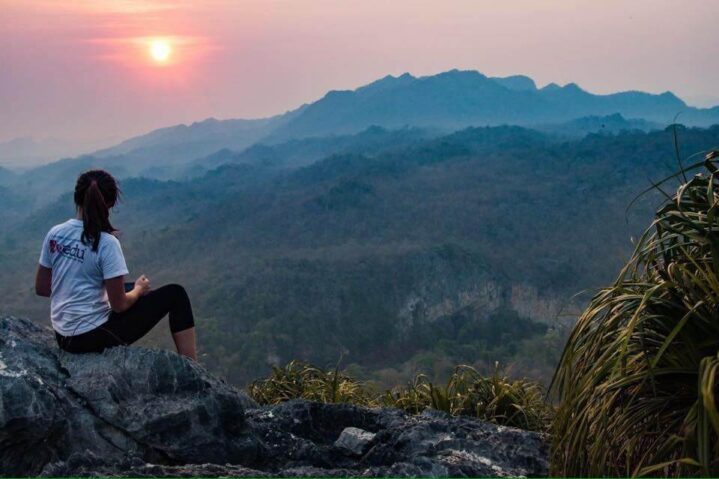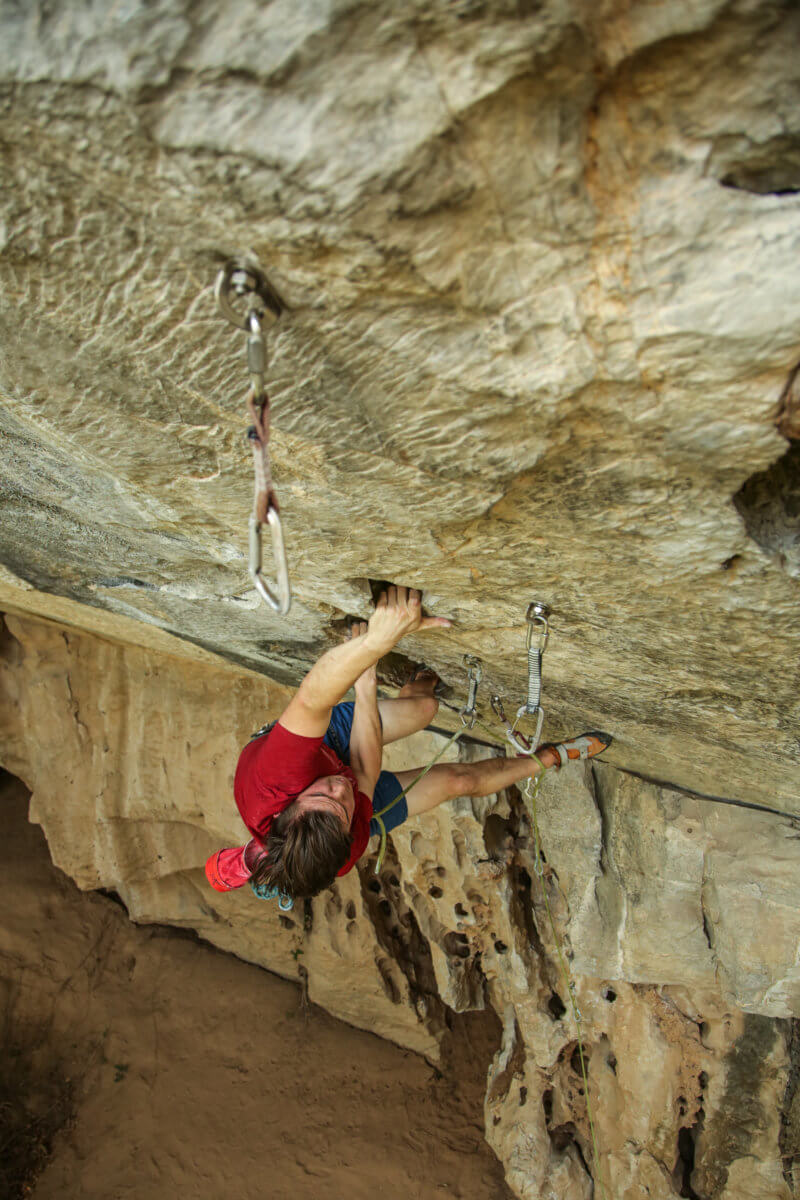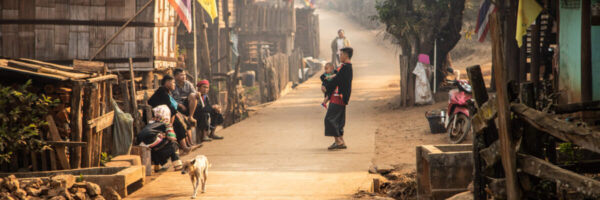
Nam Pha Pa Yai: A climber’s paradise
About two hours away from Bangkok there is the small town of Kaeng Khoi, off of Highway 2. Just on the edge of the town is one of those small roads that weaves through the countryside full of dogs and of old men puttering along on scooters that should have ended up in a junk heap ages ago. Twenty minutes later you have to strain your eyes to spot the hidden road on your left, tucked behind tall bushes that obscure a small, painted wooden sign. As you bump along the pothole filled road until it turns to dirt, up a rocky incline, down again, and to the end of the forested dirt road, you realise that the fact that this place is so hidden is what makes it so magical. Welcome to Nam Pha Pa Yai; my paradise.
As you step out of the car, the camp’s dogs come up, barking and wagging their tails. You take a deep breath, notice the sun shining through the trees, and suddenly hear the wind. All your senses start to wake up and your vision widens, noticing all the different forms of life around you. Under a beautiful, airy, earthen structure covered with a palm leaf roof Joy, the camp owner, sits. As you set down your bags and take a seat, all the worries you left behind in Bangkok are carried away with the soft breeze and the sounds of nature. Your signal starved phone is turned off and stashed in a bag for the weekend and is replaced in your hand by a coffee or a bag of homemade cookies, and you are at peace.
Photos by Joy Sirilak
Hopefully, you’ve come with a plan, and soon your friends are waiting at the edge of the restaurant with all their climbing gear on, looking more like they’re ready to leave on an expedition than take the easy, 5 minute stroll to the riverside. Until recently the two riverbanks were connected by a zip line and you would grab a pulley, strap yourself on, and fly to the other side with hardly a moment to take in the beauty of the cliff in front of you or the river below. Equipment must be maintained though, so these days you walk down to the sandy beach at the riverbank where a silent, smiling boat man waits to paddle you across to the other side. I’m still not sure which I enjoy more, so I’m glad we’ve had the chance to see the cliff from below lately, where it looks much more impressive.
The 40 metre high vertical cliff face is marbled with beautiful orange and white limestone and capped with grey karst. The entire cliff face is bolted with climbs ranging from 4 (beginner) to 8b (elite). As you stare from the river or the ground beneath the climbs you can see several prominent limestone tufa’s that have formed over tens of thousands of years, which is exciting enough, but not long after you are standing on top of them, heart pounding and chest heaving, having just danced up 20 metres of vertical cliff face on small edges and pockets. Victory is not yours yet, though, as the ultimate goal in climbing, the ‘send’, means you still can’t fall or rest on the rope as you scale another 15 metres. Of course, the hardest move on the route waits here for you and while telling yourself to be calm and breathe, you must reach high for two pockets only large enough to fit a single finger in each and somehow coax the rest of your body into following. Balance is key here. You move your feet precisely and deliberately and despite all the falls and failed attempts before, you have complete control over your body, and it suddenly feels easy. The elation you feel as you pull past the final move and clip your rope into the chains is unparalleled. You look around at the valley carved by the river, the mountains in the distance, and the vibrant orange of the rock and think that though you know you don’t belong here, that no human does, you can’t help but feel that cliff was made to be climbed. Soak it up. Send days are rare, as they should be.
Climbing is incredibly addictive. You always have something to challenge yourself with, but you feel constant progression. Even when you can’t finish a route, you find yourself getting higher and higher, sometimes metres, sometimes by just centimetres, but the progress is very real. You see yourself quite literally reaching a new level. Like many sports, it’s more mental than physical, which makes it all the more rewarding when you gain control over your mind, push through the (very rational) fear of falling and find the flow in the movement of your body.
Photos by Joy Sirilak and Nick Bernhardt
Climbing has an addictive community, too. You don’t compete with your fellow climbers, but encourage them from the ground to breathe slowly, push hard, and get to the next rest. Your climber is literally putting their life in your hands when you belay, and for the 20 minutes that are connected by that rope when you climb, you can feel their calmness or their anxiety travel through the rope to you. They have the power to calm and relax you, to psych you up, or to make you nervous all by how they handle the rope and without saying a single word. When you send, you celebrate with your belayer, you say “You kept me calm. I couldn’t have done it without you.” Your friends’ achievements are yours and at the end of the day, after exhausting yourselves, getting back in touch with nature, and admiring the beauty of the world, you all share a beer and a laugh together.
I have so much passion for climbing but it all grew in this place. I love it so much that I’m worried although the climbs that the camp was built for are incredible, maybe you aren’t a climber and feel you aren’t welcome. You are, and you should still come. Perhaps I should convince you by telling you about the hiking, which leads to a stunning view of the river worn valley and, if you time it right, reveals the mountain landscape bathed in the light of dusk or dawn? Maybe you would prefer a more relaxing adventure, and you should kayak down the river and wave to the local fishermen along its banks, take a swim, or just bask in the sun. It’s not unlikely that you already spend enough time running around for work or getting your kids to school and their activities and you just need to glance around the camp on your own long enough to find the hammocks and the yoga mats, and to listen to the creaking bamboo and the breeze rustling the leaves. You can always wander over to the vegetable garden where our friend Natalie is starting to grow Thai cocao for her young and blossoming artisanal chocolate brand, Xoconat. The truth is that you don’t need my help once you arrive. Just get yourself there, and I promise you will fall in love with this little escape.
No matter what your motivations are in going, you should absolutely try your hand at climbing. Climbers are a friendly crowd and are happy to share their knowledge. The camp offers harnesses, climbing shoes, and other gear for rental, as well as guides available for hire. There are routes for all levels of difficulty and please trust me when I say that you do not need to be a skinny athlete to try this amazing sport out. I was a complete beginner when I first came to Nam Pha and I have fallen on every route there. Climbing rock, just like climbing a ladder, is not about strength, but balance, body positioning, and how you use your feet. Try it out and you just might fall in love with it!
Photos by Kelsey Gray
Contact information
Bookings at the camp can be made with Joy Sirilak, she is reachable on the Nam Pha Pa Yai Climber’s Camp facebook page (https://www.facebook.com/nppycamp). She speaks English well enough to assist you with any enquiry. Camp information is located on the page as well, such as the location, and she can also provide information and contact for anyone who wishes to visit the camp without their own transportation, such as by train, bus, or taxi. Xoconat by Natalie is also best contacted through Facebook and I strongly recommend her artisanal chocolate: https://www.facebook.com/xoconat/
If you have any other questions about the climbing camp or anything in this article, you are welcome to contact me directly at the email address listed below.
**Since the writing of this article, the river wall has been temporarily closed. Nam Pha is an amazing place with many other wonderful things to experience and I strongly urge all of you to go, but please respect the temporary closure of this part of the camp.
Nick Bernhardt is an American who has been living in Thailand for 9 years. He owns a consultancy firm that performs market research and due diligence work and enjoys climbing, motorcycles, and exploring Thailand’s paths less travelled. He can be reached at [email protected].









